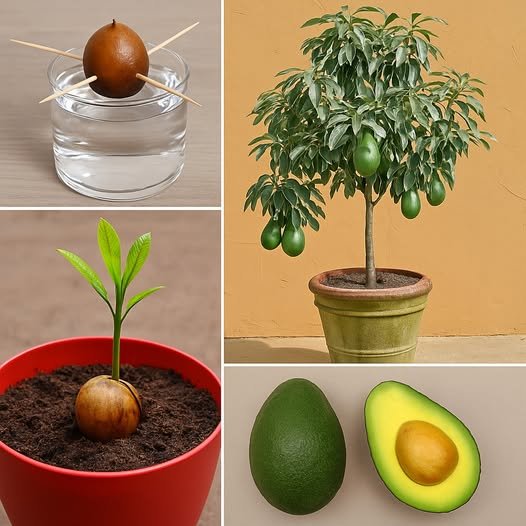How to Propagate Avocado Trees from Cuttings: A Simple Step-by-Step Guide
Avocado trees are prized for their delicious fruits, which are packed with nutrients and flavor. While growing avocados from seed is a common practice, it can be a slow process, and the trees grown from seeds often take years to bear fruit. An alternative method is to propagate avocado trees from cuttings, which can result in faster growth and the ability to produce clones of the parent tree.
In this guide, you will learn how to propagate avocado trees from cuttings using natural rooting hormones like onion and aloe vera gel, along with a few simple materials. With the right care and patience, you can have healthy avocado roots and shoots growing in just over a month.
Step 1: Select Healthy Avocado Branches
The first step in propagating avocado trees is to select a healthy, young branch from an existing tree. This branch should be a semi-hardwood, meaning it’s firm but still green and flexible. Choose a branch that is about 5 to 8 centimeters long, with a few nodes (the points where leaves grow), as these are where roots will form.
Use clean, sharp pruning shears or a knife to cut the branch at a slight angle. This will maximize the surface area for rooting. Make sure that the cutting is free from any disease or pest damage, as healthy cuttings have a better chance of successful rooting.
Step 2: Apply Onion Root Hormone
One of the most effective natural rooting hormones is onion. Onions contain sulfur compounds and other natural chemicals that encourage root growth while also protecting the cuttings from harmful bacteria and fungi.
To use onion as a rooting hormone:
Crush a few slices of fresh onion.
Soak the crushed onion in a small amount of water for about 15–20 minutes.
Strain the mixture to separate the solid pieces, leaving you with a garlic-infused water solution.
Dip the base of each avocado cutting into this onion solution for a few seconds before proceeding with planting. This treatment will help promote root growth and prevent the spread of pathogens.
Step 3: Use Aloe Vera Gel for Root Support
Aloe vera gel is another powerful natural substance that can enhance root development. It is rich in vitamins, minerals, and plant growth hormones that support the healthy growth of roots in cuttings.
To use aloe vera:
- Cut a fresh aloe vera leaf and extract the gel from the inside.
- Apply a generous amount of aloe vera gel to the cut end of the avocado branch, making sure it covers the area that will form the roots.
The aloe vera gel will not only promote faster root growth but will also protect the cutting from dehydration and help it recover from the cutting process.
Step 4: Wrap the Avocado Branch in Tissue
After applying the aloe vera gel, wrap the cut end of the avocado branch in a damp tissue. This helps retain moisture around the cutting and keeps it hydrated as it develops roots. The tissue will also act as a barrier, preventing excess moisture from evaporating and ensuring the cutting remains well-hydrated.
Be sure to keep the tissue moist but not soaking wet. Too much moisture can lead to rotting, so it’s important to strike a balance.
Step 5: Plant the Avocado Branch in Sand
Next, prepare the planting medium. Sand is an excellent choice for propagating avocado cuttings because it offers great drainage, which is crucial for preventing rot. You can use coarse sand or river sand, which allows excess moisture to drain away while still providing enough moisture to encourage root formation.
Fill a small pot or seed tray with the sand. Before planting the avocado cutting, dampen the sand lightly with water to keep it moist. Then, insert the cut end of the avocado branch into the sand, burying it about 3 to 4 centimeters deep. Gently press the sand around the base of the cutting to secure it in place.
Step 6: Place in a Shady Location
After planting, place the pot or tray with the avocado cuttings in a shady location where they can receive indirect light. Avoid direct sunlight during the rooting process, as it can dry out the cuttings or cause them to wilt. A location with good airflow but protection from harsh light is ideal.
In the beginning, maintaining a consistent temperature and humidity level is essential for successful rooting. If you live in a particularly dry area, you can cover the cuttings with a plastic dome or plastic wrap to retain moisture and create a mini greenhouse effect.
Step 7: Watering the Cuttings
Proper watering is key to ensuring the success of your avocado cuttings. During the rooting process, you should water the cuttings at least twice a day — once in the morning and once in the evening — to maintain consistent moisture levels in the sand. However, it’s important not to overwater the cuttings, as this can lead to root rot. Always check that the sand is damp but not soaking wet.
If you notice that the sand is drying out too quickly, you can mist the cuttings with water throughout the day to keep the humidity levels high.
Step 8: Monitor Progress and Root Development
After about 32 days, the avocado roots and shoots should begin to grow. You can check the progress by gently tugging on the cutting. If it resists being pulled up, this is a sign that roots have formed. You may also begin to see small shoots and leaves sprouting from the cutting, indicating that the plant is starting to establish itself.
Once the roots have developed fully and new growth appears, the avocado cutting can be carefully transplanted into a larger pot or directly into the ground, depending on your preference and available space.
Final Thoughts
Propagating avocado trees from cuttings is a rewarding and relatively simple process when using natural methods like onion and aloe vera gel. With patience and care, you can grow strong, healthy avocado trees that are clones of your favorite tree, ensuring that you enjoy the same high-quality fruit.
Try this method at home, and in just over a month, you could be well on your way to growing your own avocado trees!



